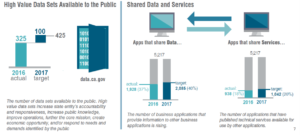California’s Tech Strategy Mirrors that of Large Enterprises
Chris Cruz’s discussion about the decisions being made by the state of California reminds me of the data strategy currently being pursued by large enterprises. A key IT strategy for large enterprises currently involves gathering data already being generated, cleaning it up until it is useful, and then analyzing it to support decision-making. Cruz referred a number of times to cost being a key driver for California’s stakeholders, so the decision to open the state’s data to the public for analysis by others is an especially clever one – enabling the same strategy at a fraction of the cost1.
The Open Data Portal
The open data portal at data.ca.gov was launched in September 2016 and contains 325 datasets ranging in focus from environmental to socioeconomic (http://www.techwire.net/innovation/california-launches-first-true-open-data-portal.html). Impressively, the state is also demonstrating a commitment to the quality of the data. They are responding to concerns from data scientists that the datasets are in poor shape for analysis by setting metadata standards to expedite analysis (http://statescoop.com/california-open-data-portal-report-targets-messy-dat). The state is also making efforts to increase the number of available datasets and increase the sharing of data between software and services1:

California – a Large Enterprise
The situation reminds me of large US enterprises. According to surveys, companies with 1000+ employees have indicated that they are committed to using the data they generate to try to improve their decision-making and open up new opportunities (https://www.forbes.com/sites/louiscolumbus/2016/05/22/51-of-enterprises-intend-to-invest-more-in-big-data/#27dff2471f61). Leveraging data to improve decisions is easier said than done, however, and large enterprises are uniquely disadvantaged. Their strategy over the previous decades has been one of specialization in a profitable market followed by cost-cutting and incremental improvement (https://hbr.org/2012/09/why-big-companies-cant-innovate). Neither of these is consistent with the sort of system-wide overhaul that would be required to make data easily accessible. It resonates with Cruz’s ongoing efforts to move employees of the state of California to consistent software solutions to reduce costs – he mentions for example recent efforts to transition every employee to a single email provider. At 138 agencies and nearly 200,000 employees, California is not unlike a very large company. As a large company, it suffers from the same barriers of inertia, budgetary constraints, and risk aversion that many others do.
Partnership Strategy
These barriers have led many to suggest that large companies partner directly with startups, either by selecting promising ones to nurture or by investing in a portfolio of companies (https://hbr.org/2016/02/big-companies-should-collaborate-with-startups, https://www.bloomberg.com/news/articles/2017-01-04/apple-invests-1-billion-in-softbank-fund-to-support-new-tech). California, with its ongoing budgetary constraints, is not well-positioned to support startups financially – however it can support startups by opening up its coffers of data and migrating its systems to platforms that are scalable and friendly to analysis, giving data scientists a sandbox to play in and asking only for insightful analysis in return. In this sense they are providing the resource they can share – data – to the tech community, at a fraction of what it would cost to pay directly for the same level of analysis.
Works Cited
- Daniel Barreto: MS&E 238 Lecture 1 – IT Fundamentals, 6/30/2017
Users who have LIKED this post:
2 comments on “California’s Tech Strategy Mirrors that of Large Enterprises”
Comments are closed.


Great point. I too was surprised how close to a “real” business the state operates. Cruz could easily and successfully run a large for-profit.
It was admirable how progressive and innovative the state is trying to think and operate. I couldn’t help but think that there is a key lesson that many businesses could learn from the state also. The State is trying to be a great servant to the public; prioritizing data safety, protecting peoples information. The business world prioritizes profit, making the consumer second. Examples of businesses that have prioritized the consumer have proven incredibly successful. More businesses should think about their responsibility to serve the public and operate with a greater good in mind.
Thank you Boryana for your comment.
I agree that it’s interesting to see how organizations with different stakeholders behave differently. That topic could fill a number of blog posts!